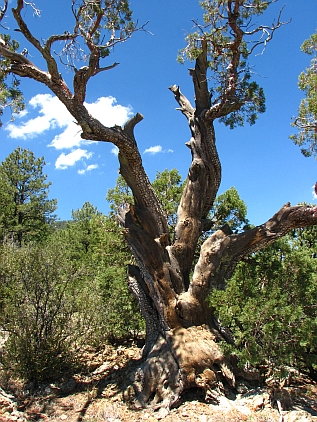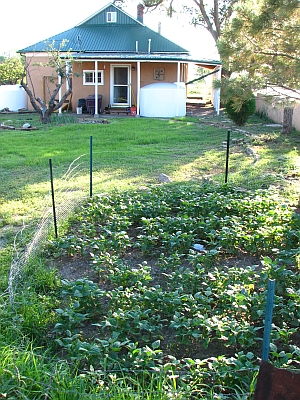
Plantings
Cropping in the high desert
Rainfall alone isn't enough for most annual crops up here. You can grow short-season dry bean (I've grown Anasazi bean, shown at right), planted at the start of the monsoon in July, in some years—if it rains frequently enough. Perennial (tree, vine, and shrub) crops are deeper-rooted and can tolerate longer periods between rains. So I first decided to grow tree fruits and drought-tolerant perennial (or short-season annual) bee forage. I didn't expect to grow for market, because although city water is cheap, I'm opposed to using groundwater for irrigation unless there's evidence that it's replenished by rainfall.
I considered pecan and pistachio, grown in the Valley and elsewhere in NM, but the elevation is too high and the climatic conditions are such that they won't thrive. Jujube might grow, but I'm not enthusiastic about its taste.
What was here
There were
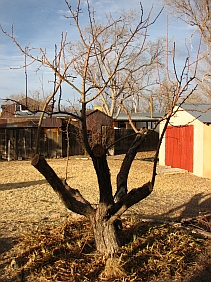
- two apple trees in the yard by the house, the older one finally dying in spring 2014. In the image, the younger one is directly behind the older one, against the wall of the shed (seen also in the third image below). The younger one is surviving but not vigorous, and is shaded from the west by the shed.
- two of what appear to be baby (or just stunted) spruce trees, visible in the shot below
- five ponderosa pines, all visible in the shot below (the big one is in the background by the stucco wall). I've covered these with a couple of shots for comparison with coming years.
- Some kind of juniper, some more lilacs, and some kind of low thorny tree, all visible in the third image below, were also growing. These had all been irrigated from plastic tubing laid underground, fed from the village main supply. I didn't approve of this choice, and pulled these lines up wherever I see them. Later, in 2017, I laid lines fed from the rainwater tanks to my gardens.
- Two apricot trees just N of the house. I pruned these when I moved in, and cut back a lot of lilac sprouts in the bed.
- A thicket of pear trees N of the main house. These were growing too thickly and I removed several. But they hadn't been watered in some time and don't look vigorous. They leafed out, but I doubt they'll ever thrive.
- A fine alligator juniper in front of the house (one of the images above). See image at the bottom of the page for an old wild specimen.
- Aside from these, the trees were Siberian elms, an aggressive non-native colonizer whose roots go after water wherever they can get it, including sewer lines. The biggest one was in front of the main house. More about these trees on the Tree care page.
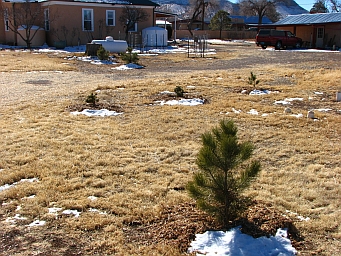
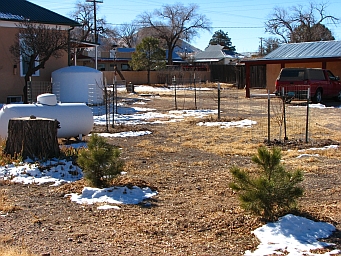
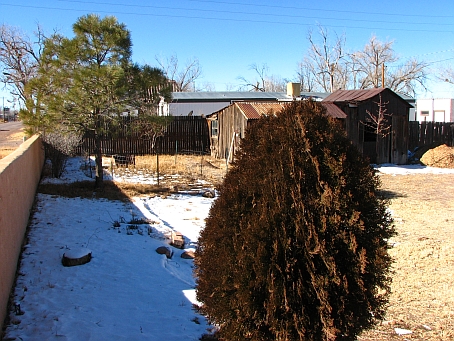
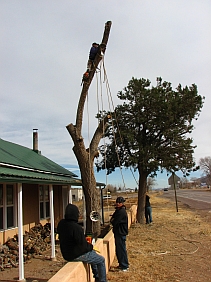
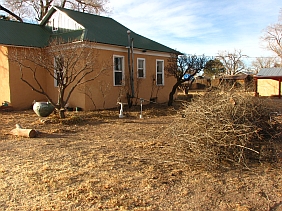
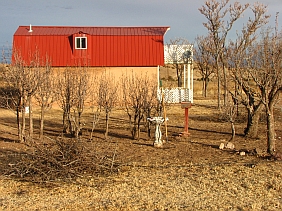
What I've planted
Spring 2013
Around the village I've seen grape, apricot, peach, apple, pear, and cherry, some of which bore fruit last year. The blossoms on the trees by the main house were killed by late frost, an event whose probabilities are shown in the WRCC plot below. Still, I thought it worth planting fruit trees. Even if the fruit is often killed, surely fruit trees are better than water-sucking invasive elm saplings.
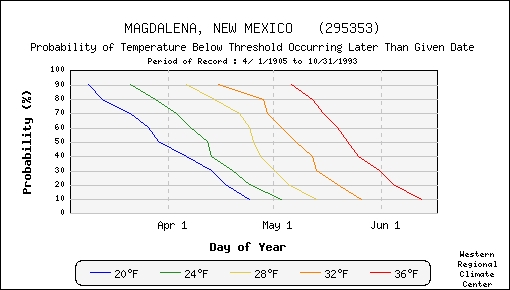
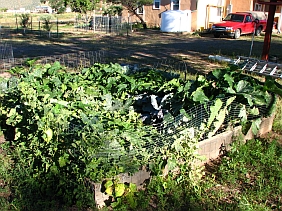
In spring I planted two almond, three peach, two cherry, two dwarf apricot, two apple, two pear, and two grapevines. The almonds are visible in the background of the garden shot, but a couple of the trees didn't thrive and will need to be replaced.
Fall 2013 and spring 2014
In November 2013 I planted 9 table grape, 6 raspberry, and a kiwi in a new vineyard site N of the greenhouses, and two standard (full-size) apricots and a nectarine (not shown). I chose at least one of the apricot varieties (Harglow) for late flowering. Also, the sloping terrain may help reduce frost pockets.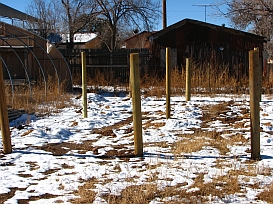
In the photo, I've already mulched all the plantings. I also planted two goji berry and two honeyberry in the garden just E of the main house (photo not yet shown, as there's not much to see as of December 2013).
All of the fall 2013 plantings but the goji berry bushes and one of the apricots died by spring. I guess I didn't water them enough.
The NM state forestry division sells native tree and shrub seedlings cheaply (49 for $64 in December 2013). I ordered a package including 21 ponderosa pines, Gambel oak, and some native drought-tolerant shrubs for planting in spring 2014. Part of the pine "avenue" is shown here.

More bareroot peaches, an apricot, cherries, and almonds were planted in spring 2014 and are growing. Two trees in pots, another Reliance peach and an Arkansas Black apple, were bought from a Los Lunas nursery and planted after the weather was already warm. They struck eventually, but not right away.
Spring 2015
I've planted another nine apple, two hazelnut, six cherry, and two jujube trees and about 16 grapevines. A late April cold night of 24° killed all of my grapevines and blasted a lot of young apricot and almond leaves, though the trees should be fine. So it's not grape country, at least in my microclimate. In the E garden I tried two more honeyberry, one of which is barely leafing and the other of which is inert. Three red raspberries are leafing, though, and last year's goji berry bushes are thriving.
Spring 2016
A few of the apples and cherries died, as did both hazelnuts and jujube and one of the raspberry. I've replaced the apples and cherries and planted a different hazelnut as well as a persimmon hybrid and a few more peaches and raspberries.
Frost smashed the apricot blossoms but as of mid-April appeared to have spared all others. But none set fruit.
All pines but the big one in the SW yard are showing the spikes that will form new upward-growing trunks. This is probably because they're no longer being neglected, but given water.
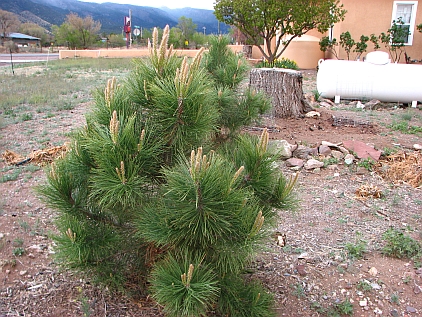
How will these plantings be watered?
Calculating the match of water supply with demand is hard to do, given that in our monsoon climate, the rainfall comes during the main growing season and fills some of the plant water requirements. Without going into quantitative details, I'm expecting that
- stored water in tanks (see the Water works page) and graywater will be adequate to support tree and vine growth in the dry spring months
- direct rainfall and runoff from unplanted areas will support them during the monsoon season
- some run-on water (from off the property—see the Land forming page) will be available for some plantings
- heavy mulching will reduce soil evaporation
- cold-season water demand will be low
For the first few years, these young plants will have plenty of water from rain and from stored rainwater and graywater. It's only when they become mature trees, shrubs, and vines that there may be some unfilled water demand—given that I don't plan to use pumped groundwater to support them. By that time we may also be experiencing severe droughts, with failed monsoon rains.
The partial aerial view below shows (what's also evident on the ground during the rainy season) that the middle section of the property is better watered than the upper and lower ones, and shows the reason why: the run-on down the driveway past the cottage, probably augmented by runoff from the roofs on the W side of the property running on down the slope. The Siberian elms grew along the foot of a dropoff (formed by the old railroad spur up to Kelly) and clustered along the same dropoff and around a basin linked to a culvert under the spur, at top left. This distribution suggests that there is more moisture in the soil fed with runoff from the railway roadbed and that this area would be a good place to plant useful perennials like fruit trees.
The greenery in the field to the NE, behind the post office, benefits from even more highway runoff through that parking lot (from the S side of the highway) than comes onto my place from the N side of the highway. The seep, formerly watering an elm grove that we cut down and replaced with two young cherry trees, is circled. My choice of sowing area for buckwheat or other annual honeybee forage is to its left, in an area at least 70' square.
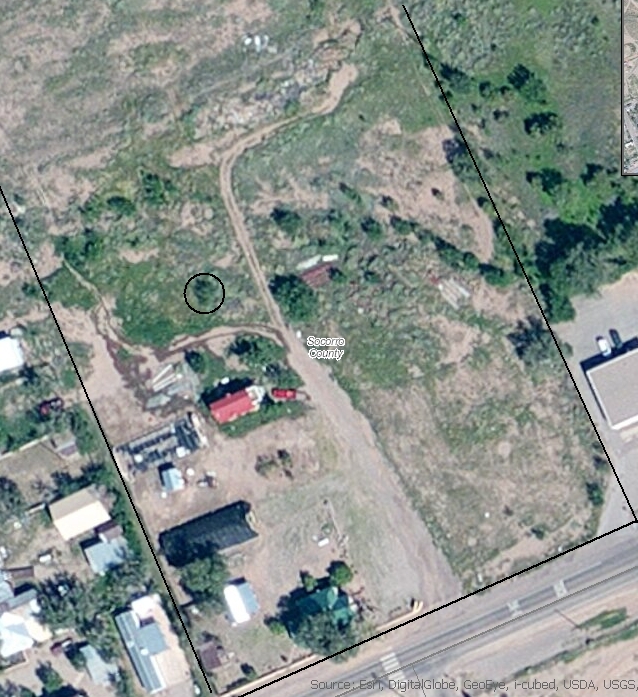
The buckwheat area was rototilled up on 6.30.14, though the dryness of the soil prevented the tines from going more than 3 or 4" deep. I planted buckwheat with a garden seeder on about 2' row spacing. This used only a fraction of the 10-lb bag. Next day I tilled up 60' x 120' just N of the detention basins and another strip 10' x 130' parallel to the dogleg in the central driveway. On 7.4 I sowed these plots with grass mixture and two wildflower mixtures from Applewood Seeds, by broadcasting, (and in a breeze) as the seed wouldn't go smoothly through a hand cyclone seeder. Three days later I spread elm mulch on these plots, rather thinly. I hoped that the monsoon would bring several consecutive days of sufficient rain to keep the ground damp; otherwise I'd have wasted 4 lb of seed for $205.
But pigweed overtook it and grasshoppers finished it off by early September. I never saw any sign of the grasses or pollinator plants. Nor did beans and Hopi corn, planted in July, get anywhere. We had less than 4" of rain through September 10. By December I had recorded 7.5" on the year.
Outcome: drought. A few buckwheat plants came up, but died. I sowed more buckwheat on 8.7 and actually got it to bloom three weeks later.
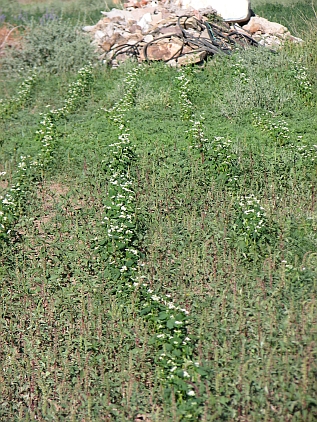
Vegetable growing 2016
I started using the hoop house to grow vegetable plant starts. Didn't do much to market them and planted too many broccoli, so had a local worker transplant them into the field near the spring N of the cottage. Inside the rabbit fence are more broccoli, lettuce, cilantro, and dill. The field had a lot of sawdusty horse stable litter tilled into it just before transplanting—I know this isn't a good idea, but there wasn't time to let it age.

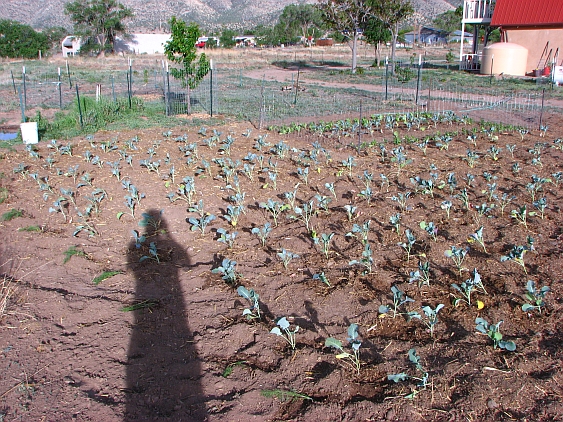
Daily watering was from the cottage tank via the hose, visible above. After four days no rabbits or deer had bothered anything. But eventually the open-field broccoli and dill got eaten off, and even the plants in the rabbit enclosure didn't thrive. Cole crops are best grown in the fall here.
Next enterprise, as I now had hundreds of plants and few buyers, was to transplant peppers, tomatoes, pumpkins, and melons into newly manured and tilled land, with the difference of digging 8" pits at 2' intervals and filling them half full of compost. The first three of these plantings weren't much bothered by animals. The melons, inside a rabbit fence, were mostly OK but something, maybe quail, grubbed holes besides some of the plants. All plantings were watered with stored rainwater or (for the melons) spring water.
By fall I got plenty of peppers for myself, but not enough (or pretty enough) to sell. This broccoli got infested with harlequin bugs and I tore it out in early July and planted sweet corn (not shown).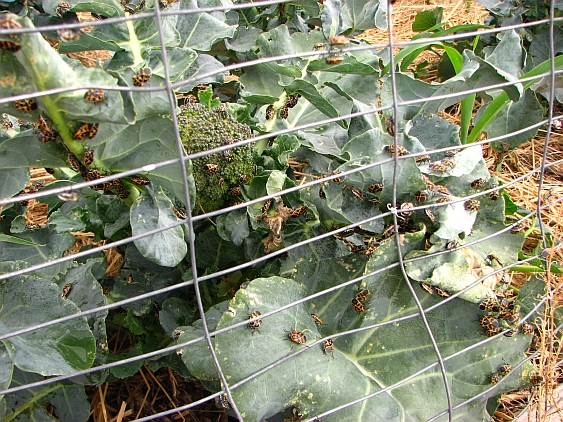
These naked-seeded pumpkin vines did poorly owing to the low soil fertility and absence of additional fertilization. In the fall I transplanted more broccoli into this plot, this time fertilizing.
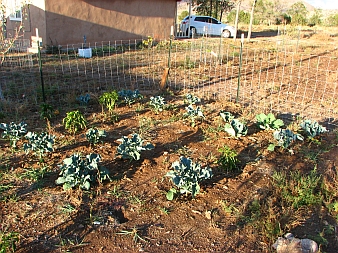
But just when the plants were heading in October, deer worked out that a 4' fence isn't much of a challenge, and ate them down to the ground.
Likewise, these tomatoes did poorly and a few vines got stripped by hornworms. In the big north field (not shown), melon vines grew very little after being set out. So all that work (a lot done by hired labor) was mostly wasted, though it did provide some employment to the guys.
To summarize the 2016 vegetable-growing season: too late soil preparation, too little supplementary fertilization, and not enough deer protection.
2017 planting
I now had 14,000+ gallons of rainwater storage. In 2016, though < 5" of rain fell from July through September, I still irrigated at least 3000 sq ft of garden without running low. This experience suggested that I could grow quite a lot of field produce on the rainwater I had, and could plant more densely too.
My neighbor on the Riley road keeps 12 horses, left from his days as a veterinarian, has a house-sized heap of stable manure mixed with bedding, and cheerfully loads up my trailer with it when I bring it out to his ranch. When I got some more labor in winter of 2016, I spread the stuff liberally on about 8000 sq feet of land. My soil appears to be alluvium washed down from the Magdalenas, and contains few rocks. The top few inches is friable, but the subsoil is packed hard and must be soaked before a hole can be dug. I till the manure in as best I can, but the tractor-drawn rotary tiller tends not to dig into the subsoil. The next few shots show the prepared plots in January 2017. Five of them won't be planted or irrigated owing to the inadequacy of my rainwater supply.
Finally, watering this stuff by hand takes a long time, so in spring 2017 I'm laying out drip lines. I'm also putting up better deer fence.
Fall 2017
I didn't mention that I planted 10 trees (apple, tart cherry, pear) from Tooley's Trees in Truchas, NM on 3.10.17 in the E field, the one with the main water-detention features. See photo below.
I also planted 49 Ponderosa pine seedlings, mostly below the railroad embankments to catch water shed off the slopes of the embankments, and ran drip line to them. I watered mostly by gravity from my tanks, but, late in the season, from hydrants with pressure reducers, which did a better job of getting water to the ends of the runs. Five or ten pines died over the summer, but the rest hung on. Lesson: when I depended on hand-watering the previous plantings, I didn't water often or regularly enough. When they can all be watered in 20 minutes, they tend to get watered enough.
On 9.25.17, I planted 8 more apple and tart cherry trees and two grapevines next to berms in the E field and also ran 1/2" main line to them for watering. The trees were planted mostly below the berms because I didn't want them to drown when the basins fill, but then I decided to plant others maybe 6' uphill of the berms so that they'll get wet feet but won't stay inundated.
In October, I planted 49 more Ponderosa pine seedlings, about 1/3 of them in the E field and the rest below the railroad embankments in various positions, and a bit later ran drip line to all of these too. The fields were grown up in weeds and I rotary-cut them, but the berms are mostly overgrown still. The cages surround fruit trees or vines; white stakes without cages indicate pines, which deer don't bother. All trees are mulched, the fruit trees first being surrounded with a disk of compost 2" or 3" thick.
The soil near the basins behind the berms was not moist when the tree holes were dug, as I hoped they would still be after the monsoon season. If there is stored water there, it's further down and may still be accessible to deeper roots of trees once they have grown with supplementary water for two or three years. If the orchard needs much irrigation, my plan to exploit mainly rainwater for growing fruit will have failed, as I don't have enough collection surface for 50 fruit trees, the pines (which will, however, need less water than the fruit trees) and a lot of vegetable garden space.
Summary of planting: where are we after 5 years?
I now have 53 fruit trees planted by me, of which one peach and three apples began in 2017 to bear small numbers of fruits. The younger, surviving apple tree near the old shed came into bearing when I tore down the shed, giving it more light, and composted around it, and bore at least 100 fruits this year. One of the old apricots just N of the house also bore a few edible fruits this year, surprisingly. Newly transplanted trees from Tooley's did produce some apples and cherries in spring, but they were pinched off so as not to interfere with tree growth.
There's room around basins on the E field for another 10 or 20 fruit trees, but I'm uncertain whether they'll ever get enough collected groundwater to thrive with little supplemental irrigation, so I don't know as of fall 2017 whether I'll plant any more.
I have around 100 Ponderosa pine trees, with the oldest of those I've planted approaching two feet in height. The value of these will be chiefly in their appearance; they will slow wind somewhat for the fruit trees, but otherwise my only purpose in planting them is the principle that the more trees we can grow, the better.
I have a few shrubs, mostly on tops of berms, and some Russian sage, mostly around the spring pond.
Of vegetable gardens, only the squash garden bore produce that could be sold; peppers were small and not in much demand, tomatoes were small and good only for drying (as happens every year), and a melon patch sown for market mostly failed. Sweet corn did indifferently. Spring snap pea vines did poorly and may have been eaten by rabbits. Sweet potato vines did indifferently, only two or three producing a total of some 5 lb of tubers. Pumpkins grown for naked seed produced 1 or 2 lb of dry seed, but the hand processing took an hour or two (incidentally, cut them equatorially to scoop out the seed, as then few or no seeds will be cut; also wait until they're nice and ripe, as the seed then begins to separate better from the pulp).
I suspect that a roadside stand offering melons, tomatoes, and sweet corn along with squash and snap beans at the appropriate times of season would do pretty well (meaning provide a little beyond the cost of growing them).
My nopal is nowhere near abundant enough to plant over a large area, though I propagated 15 pads this year.
Strawberries are hanging on but raspberries don't do well.
2020
Though I make lots of horse-manure compost and till plenty into my gardens, the soil still doesn't seem very fertile. All gardens are now rabbit- and deer-protected by fencing. In 2018, summer squash and sweet corn brought in a few $00 from a serve-yourself table in front of the house, but labor of planting and other ancillary services done by mostly Navajo workers cost much more than the sales returned. As a rule the plantings and transplantings, which are done by hand because the plants need to be near the emitters, succeed only patchily, I suspect because the labor is done patchily. Except for one year (2018) when transplanted broccoli and cauliflower (this latter a first-time crop for me) headed there, the spring garden has been a bust; corn and melons don't grow or if they did were dug up by birds or eaten off by rabbits, which are now excluded. Yet the soil is deep and loose.
The following shots show the growth of fruit and pine trees over the last few years.
Pine alley, started in spring 2014. Some have grown nearly 6' in six years.
Pine alley with E orchard behind. All trees not on the ridges are on drip line, but the young fruit trees are also watered manually in dry weather (in 2020, 5 gal weekly) because it's dubious that the 1/4" drip extensions from the 1/2" main line are soaking the soil sufficiently.
These pines have grown 4' in six years. The peach seen between typically does not put on lush foliage, especially early in the season.
Pines and house orchard from N.
Spring orchard from NE. Big sweet cherry behind Russian sage behind the spring pond.
E orchard from W
Asparagus garden planted 2019 from crowns. Compare old apricots with those in older photos.
The garden in the foreground contains Russian sage in foreground, several asparagus plants behind.
Almonds at left, apricots at right, asparagus in fenced plot behind.

